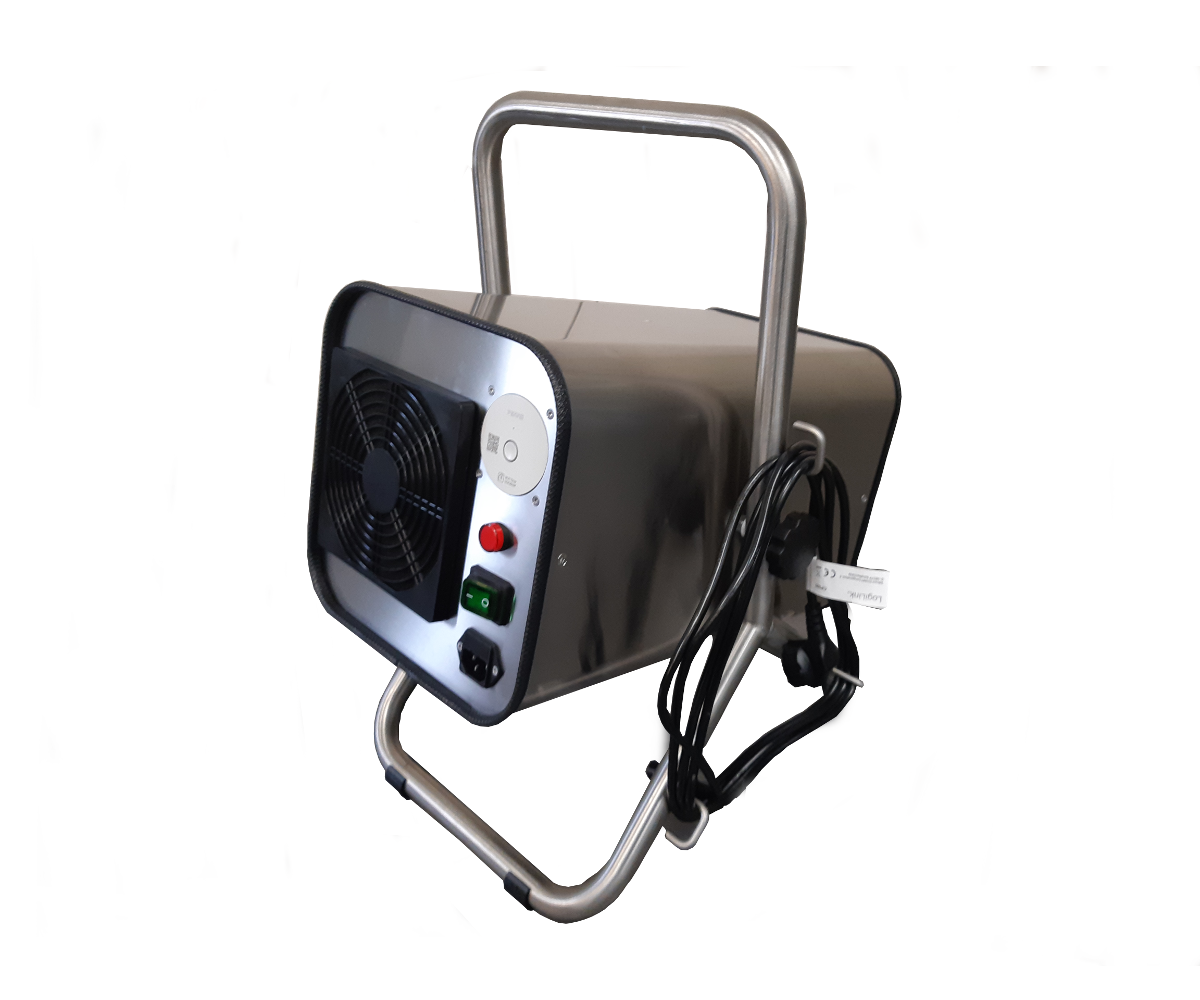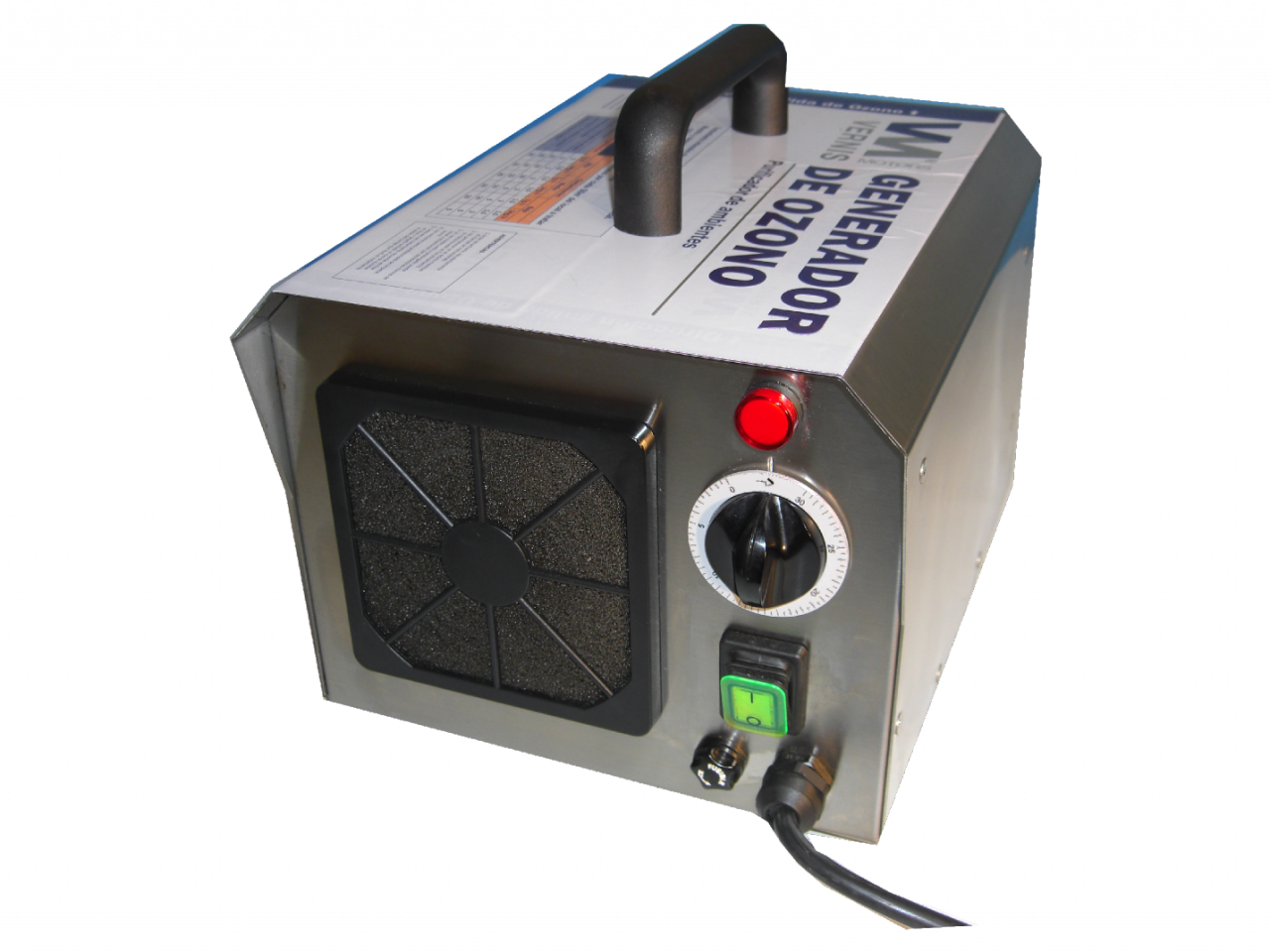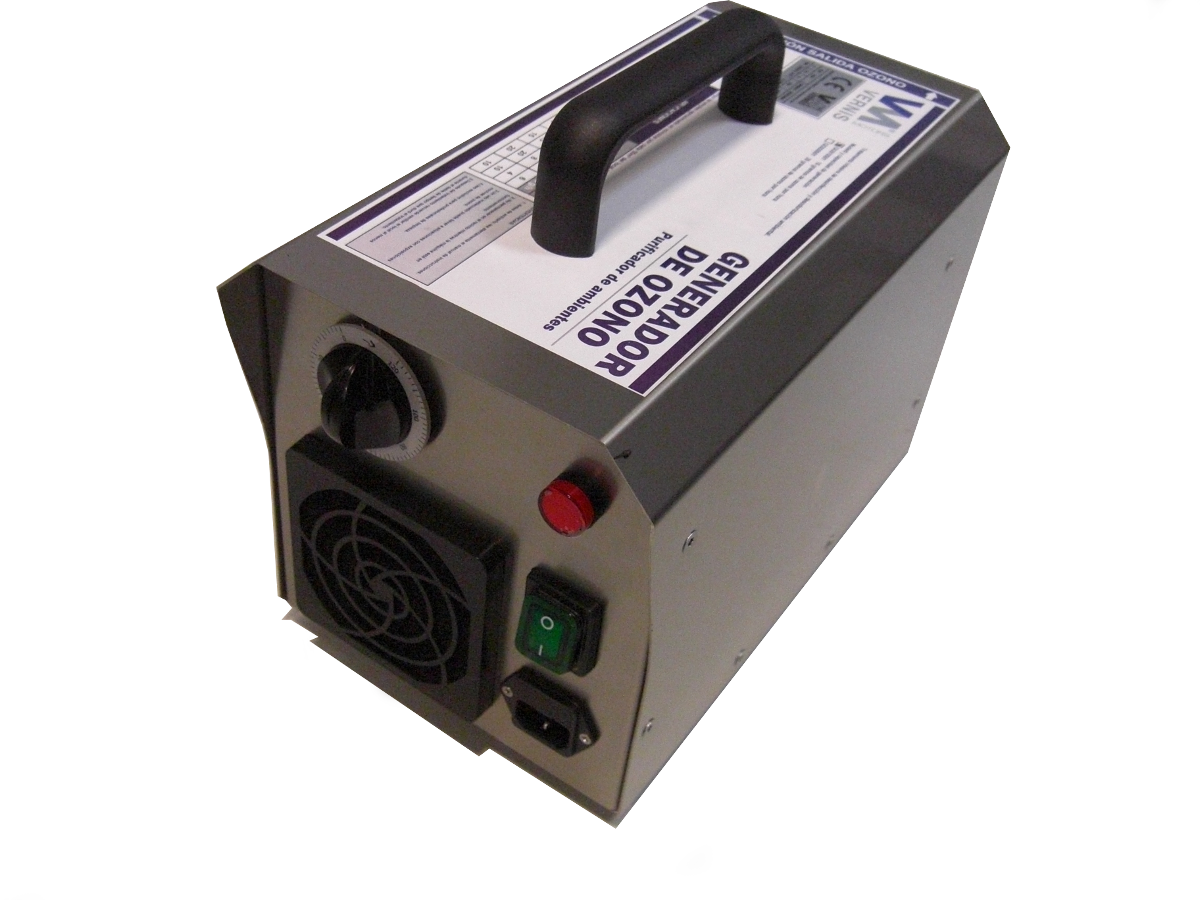OZONE GENERATORS
Direct discharge and portable ozone generators, specially designed to purify and disinfect environments.
The VERNIS models generate ozone through a system of electrical discharges, which are obtained by applying a high voltage alternating current between two electrodes where a dielectic is located.
Thanks to the combination of its robust and lightweight design, its easy handling and the variety in the power range, this machine is suitable for both domestic, professional and industrial use in the Division.
Model
G0-40
Generador de Ozono portátil para el tratamiento del aire de 40 gramos por hora

Robust and lightweight design
Stainless steel housing. The use of high-tech elements allows the generation of significant amounts of ozone in a reduced size and weight. Anti-vibration handle and feet make it easy to transport and place the machine on multiple surfaces.
Simple operation
A switch (ON / OFF) activates or deactivates the equipment. The 30 minute countdown timer starts the ozone generator. The LED indicates if the machine is performing disinfection.
Safety measures
Machine equipped with earth connection. A protection fuse protects against possible breakdowns.
Characteristics
Timer: 1-30 Minutes
Ozone output. Direct pour
Air flow: 2 s 120 m3
Power: 220W
Voltage: 230 V
Frequency: 50 Hz
Dimensions: 255x235x300 mm
Weight: 6.5 Kg
Model
G0-20
Portable Ozone Generator for air treatment of 20 grams per hour

Robust and lightweight design
Stainless steel housing. The use of high-tech elements allows the generation of significant amounts of ozone in a reduced size and weight. Anti-vibration handle and feet make it easy to transport and place the machine on multiple surfaces.
Simple operation
A switch (ON / OFF) activates or deactivates the equipment. The 30 minute countdown timer starts the ozone generator. The LED indicates if the machine is performing disinfection.
Safety measures
Machine equipped with earth connection. A protection fuse protects against possible breakdowns.
Characteristics
Timer: 1-30 Minutes
Ozone output. Direct pour
Air flow: 2 s 120 m3
Power: 220W
Voltage: 230 V
Frequency: 50 Hz
Dimensions: 255x235x300 mm
Weight: 6.5 Kg
Model
G0-10
Portable Ozone Generator for air treatment of 10 grams per hour

Robust and lightweight design
Stainless steel housing. The use of high-tech elements allows the generation of significant amounts of ozone in a reduced size and weight. Anti-vibration handle and feet make it easy to transport and place the machine on multiple surfaces.
Simple operation
A switch (ON / OFF) activates or deactivates the equipment. The 30 minute countdown timer starts the ozone generator. The LED indicates if the machine is performing disinfection.
Safety measures
Machine equipped with earth connection. A protection fuse protects against possible breakdowns.
Characteristics
Timer: 1-30 Minutes
Ozone output. Direct pour
Air flow: 2 s 120 m3
Power: 220W
Voltage: 230 V
Frequency: 50 Hz
Dimensions: 255x235x300 mm
Weight: 6.5 Kg
Explanatory video of the operation of the Ozone Generator.
Frequent Questions
¿What is ozone?
Ozone is a gas that contains three oxygen atoms for each molecule. The combination of an oxygen molecule (O2) with an oxygen atom (O) will lead to the formation of ozone (O3).
Its natural state is gaseous, found in the air, near the surface of the Earth, in very small quantities, its proportion being approximately 20 ppmm (parts per billion) or 0.02 ppm (parts per million).
What is less known about ozone is its great efficiency as a biocide, due to its oxidizing power, which also allows its use as a deodorant and in the elimination of all types of chemical pollution, both in water and in air.
What is ozone for?
Ozone is ten times more powerful than bleach or chlorine, it destroys viruses, bacteria, germs, nematodes, fungi and other microorganisms at a lower concentration and contact time than with chemical products. With ozone concentrations of 0.1-0.2 mg / L.min, a 99% inactivation of rotavirus and polyvirus is achieved, among other pathogens studied, belonging to the same Group IV of Coronaviruses.
Its strongly oxidizing nature makes it a particularly useful tool in the agro-food industry, since, to its high efficiency in the elimination of microorganisms and polluting chemical compounds, the great advantage of not leaving residues is added: ozone is rapidly decomposes into O2.
Due to its oxidizing capacity, as well as its instability, which makes it quickly revert to oxygen, ozone can be used in any process that requires fast and effective disinfection:
In air, ozone is used to disinfect indoor environments, in order to ensure the microbiological quality of the air, as well as to control odors: cold rooms, dry food disinfection, gyms, waste management plants, etc.
Dissolved in water, it is used for purification, recovery of wastewater for irrigation and recreational uses, washing in the Food Industry of food and work tools in contact with them, washing clothes (in industrial, community or private laundries), irrigation water , gas scrubbing, ice making, Legionella control, etc.
How does ozone work?
Ozone introduced into any environment performs 3 very important actions:
1.- MICROBICIDE: It is the most important property of ozone and for which more applications are attributed. Its high oxidizing power allows it to kill most microbes, bacteria and viruses in the environment.
2.- DEODORANT: It is one of the most proven properties, due to its great utility in all types of public use premises and in the treatment of certain industrial-type odors. Ozone oxidizes organic matter (ozonolysis) and on the other hand attacks the microbes that feed on it.
3.- OXYGENANT: In large cities, where there are a large number of closed and poorly ventilated places, the thinning of the air is very often noticeable as a result of a lack of oxygen. Ozone contributes to improving the efficiency of the cells of higher organisms in terms of the use of available oxygen by stimulating various enzymes involved in these processes.
What advantages / benefits does ozone offer?
1.- According to the World Health Organization (WHO), ozone is the most powerful disinfectant against all types of microorganisms.
2.- Its disinfection power is at least ten times greater than that of chlorine, being 99% effective in eliminating viruses, but also in bacteria, protozoa, nematodes, fungi, cell aggregates, spores and cysts.
3.- Ozone oxidizes cytoplasmic substances, while chlorine only produces a destruction of vital centers of the cell, which sometimes is not effective, so the microorganisms manage to recover.
4.- It is much less corrosive and polluting than disinfection with bleach or chlorine.
5.- It is faster, needs less contact time with microorganisms than other disinfectants to carry out purification and acts at a lower concentration.
6.- It is less polluting since the sodium hypochlorite solutions end up with it in the water, putting the life of non-harmful species at risk.
7.- It is much more effective than liquid biocides, because it expands and reaches absolutely every corner.
8.- In addition to being a magnificent disinfectant, it is a great deodorizer, leaving behind a very pleasant smell, unlike bleach and chlorine.
9.- According to the WHO, it is detailed that with ozone concentrations of 0.1-0.2 mg / L.min, an inactivation of 99% of rotavirus and poliovirus is achieved, also belonging to group 4 of the coronaviruses .
How is ozone produced?
Ozone is obtained industrially by passing a stream of air or oxygen between two electrodes subjected to a high alternating potential. In order to avoid the formation of an electric arc, one of the electrodes, or sometimes both, is covered with a dielectric of uniform thickness that creates an equipotential surface. This allows the oxygen molecule (O2) in the air to be decomposed into two oxygen atoms (O), which join with another oxygen molecule (O2) to form Ozone (O3), being then released into the environment.
How does ozone disinfect?
Ozone is considered one of the most energetic oxidants in nature, since its electrochemical potential is 2.07 eV, compared to 1.36 eV for chlorine gas, rapidly oxidizing organic structures, which makes it the sterilant widely used AND MORE ECOLOGICAL.
As the electrons are sharing between three atoms instead of between two, the resulting molecule is very unstable, and it tends to capture electrons from any compound that comes close to it to regain its stability; that is, it is a strong oxidant.
Hence its extraordinary biocidal, deodorizing and chemical compound destruction properties: by capturing electrons from other molecules, oxidizing them, it destabilizes them to the point of destroying them if the ozone concentration and / or contact time is sufficient.
What side effects or what danger does the use of ozone pose?
Ozone is a powerful oxidant, generally not harmful to mammals at low concentrations, but lethal to microorganisms such as bacteria. In any case, ozone, like any other oxidizing agent, can be harmful if it is not handled correctly in its airborne applications.
The only route of ozone exposure is inhalation, that is, if you breathe in large amounts (higher than those recommended in the regulations, or for long periods of time).
Due to its irritant nature, exposure to ozone, you must respect the recommendations issued by the WHO.
- Safety recommendations of the UNE 400-201-94 standard: <100 µg / m³ (equivalent to 0.05 ppm) as maximum for use in the presence of people or animals.
- The Environmental Limit Values (VLA) of the INSHT (National Institute of Safety and Hygiene at Work) establish exposure limits for ozone depending on the activity carried out, the most restrictive value being 0.05 ppm (daily exposures of 8 hours) and 0.2 ppm for periods less than 2 hours.
- The EPA (US Environmental Protection Agency) sets a standard of 0.12 ppm for 1 hour of exposure.
- The WHO (World Health Organization) proposes a reference value of 0.05 ppm or 0.1 mg / m³ for a maximum period of 8 hours.
- If you breathe in large amounts, ozone can cause eye or throat irritation, which usually happens after breathing fresh air for a few minutes.
Can I disinfect my business with ozone?
Disinfecting with ozone is one of the best investments to disinfect both air and water. In our case, the ozone generator produces ozone and melts it into the air. Depending on the volume of the room or space to be disinfected, one model or another of generator will be required.
The advantages are enormous:
- Without extra personnel for its assignment.
- Without interrupting or delaying your daily cleaning work.
- Without chemicals.
- No odor residue, it does not camouflage odors, it destroys them.
- No installation costs.
- A few minutes a day, they guarantee an environment free of viruses and bacteria.
- Very easy handling of the ozone generator.
Where can ozone be used as a disinfectant?
Sure we will leave many, but here is an indicative list:
+ Home
+ Offices
+ Vehicles
+ Garages
+ Storage rooms
+ Shops of all kinds (clothes, shoes, food, perfumeries, etc.
+ Beauty centers
+ Hairdressers
+ Nail salons
+ Yoga and / or Pilates rooms
+ Childcare centers
+ Schools
+ Cabinets
+ Gyms
+ Coaching or personal training rooms
+ Driving schools
+ Bars and Pubs
+ Restaurants
+ Hotel rooms of all kinds
+ Geriatric residences
+ Municipalities
+ Sports clubs
+ Dressing rooms
+ Booths or stays of domestic animals / pets
+ Clinics (dental, veterinary, aesthetic medicine, etc.)
+ Common areas of neighboring communities
+ Receptions
+ Meeting rooms
+ Co-working spaces
+ Call centers
+ Washbasins
+ Game rooms
+ Video game rooms
+ Cinemas
+ Kiosks
+ Fleet of rental vehicles
+ Boats
+ Aircraft
+ Trains
+ Waiting rooms
USEFUL FOR

Hospitals

Elderly Residences

Public Transport

Funeral Homes

Hotels

